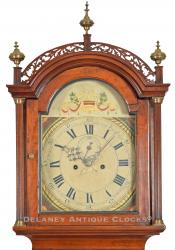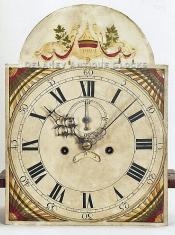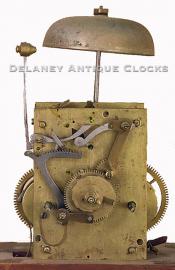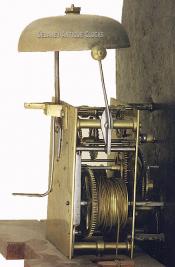An unsigned cherry case tall clock cross-banded in mahogany. The movement was most likely made by Jacob Jones of Pittsfield, New Hampshire. 25124.
This fine cherry case exhibits traditional New England proportions. It is a very manageable size measuring approximately 7 feet 8 inches tall to the top of the center finial. The case is constructed in cherry, New England white pine as a secondary wood and mahogany cross-banding details.
This case stands on applied bracket feet. They incorporate a nice return into their design. The base panel is trimmed with a mahogany cross-banded border. The waist section is long and narrow. The waist section is fitted with a rectangular-shaped door that is trimmed with a delicate molded edge. This door is also cross-banded in mahogany. One would open this door to access the weights and pendulum. The corners of the waist feature reeded quarter columns that terminate in brass quarter capitals. The bonnet is surmounted with an open fretwork pattern. The three reeded chimney plinths are capped at the top and support the three-period brass finials. The bonnet columns are also reeded. They are free-standing and mounted into brass capitals. They flank the arched glazed door.
The iron dial is decoratively painted with a geometric theme. This dial was painted by the Nolen & Curtis firm in Boston, MA.
This fine movement is constructed in brass and is of good quality. The construction of which suggests that it was made by Jacob Jones of Pittsfield, NH. If you compare this movement to the clock pictured in Russ Oechsle's groundbreaking book, "Without Equal, The clocks of Abner Jones of Bloomfield, New York," you will see the similarities in design. Four-turned pillars support the two brass plates. Hardened steel shafts support the polished steel pinions and brass gearing. The winding drums are grooved. The escapement is designed in a recoil format. The movement is weight driven and designed to run for eight days on a full wind. It is a two-train or a time-and-strike design having a rack and snail striking system. As a result, it will strike each hour on the hour. This distinctively shaped hammer on a cast iron bell mounted above the movement.
This clock was made circa 1810.
Jacob Jones was born on December 30, 1749, in Kingston, New Hampshire. He was the son of John Jones (1724-1815) and Hannah Dow (1728-1806). Jacob was Trained as a clockmaker under the guidance of Daniel Balch of Bradford and Newbury, Massachusetts. Jacob married Hannah Cilley on January 1, 1774, in Pittsfield, NH. They had eleven children. Three sons worked in the clock trades. Joseph was born on March 37, 1775, and died on October 31, 1842. Jonathan Jones was born in Gilford, NH, on October 16, 1787. His death date is not known. Abner Jones, not to be confused with his third cousin Abner Jones of Weare, NH, was born on August 24, 1789, in Pittsfield, NH, and died in Avon, NY, on August 24, 1876.
Jacob had a foundry and workshop near the Quaker Meeting House in the Doeboro district of Pittsfield, NH. Here he cast the brass he used to manufacture his clocks. Jacob died in Pittsfield on July 25, 1839. In his book New Hampshire Clockmakers, Charles Parsons reports that fifteen tall case examples are known to have survived by this Maker. It is not known if this is one of those examples. The Currier Museum of Art in Manchester, NH, has an excellent example in its collection. Their clock features an engraved dial and a lovely tiger-maple case. It was thought to have been made circa 1785. We have recorded two other engraved sheet dial clocks. One of which is engraved with the date 1792 in the arch. Interestingly, the engraving on the two dials appears to be of different hands.












